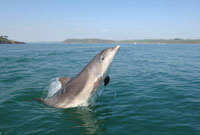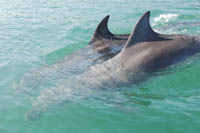Update 3: 16 May By Aidan Fleming This nice shot by Aidan Fleming taken at 19:00 on 16th May is of one of the pod of bottlenose dolphins bow-riding the LE Aisling, east of Cobh Town, near the Cork Harbour pilots station. This is the 4th consecutive day that these dolphins have remained in the inner harbour area.
Update 15 May 2007 By Conor Ryan
Having spent yesterday in the Passage West/Lough Mahon area of Cork harbour inner, this morning 15/05/07, I observed them off Whitepoint, trapping fish between the naval vessel LE Ciara (fast alongside) at 07:45 and heading upriver. They were feeding on shoals of Thick-lipped grey mullet Chelon labrosus, rounding them up near the Rafeen Creek, Monkstown mudflats. They then headed upriver.
Conor’s photo below, shows an adult bottlenose dolphin tossing a mullet this morning 15/05/07, thus ending our speculation that they may have been feeding on salmon!
Report 14/05/07
The bottlenose dolphins (Tursiops truncatus) which have been observed on a regular basis at the outer Cork Harbour for the past 15 months, since Feb. 2006, have now been joined by additional animals which were observed and reported on 13/05/07 from the car ferry which crosses the River Lee between Passage West and Great Island, Cobh. They remain in the same area this morning 14/05/07 between White point and Ringaskiddy, where they have been observed feeding in water as shallow as 2-3m.
Local IWDG members, Conor Ryan and Peter Wilson who published a paper on the 3 killer whales which entered Cork Harbour in similar circumstances, have in the past 15 months been monitoring a pod of six “resident” bottlenose dolphins, which in favourable weather can be seen on a near daily basis from places like Roche’s Point, Camden and Carlisle Forts.
Close up observations from the Passage West car ferry on Sun. 13/05/07 and photo identification images of their dorsal fins suggest that these are not the same bottlenose dolphins which have been observed in the outer harbour, but are a new and larger group of older animals.
Although we’re speculating here, their behaviour suggests they are feeding, although it is not as of yet possible to determine on which fish species. When the killer whales moved into the same area in early June 2001 it was clear that they were initially feeding on salmon, which were running in the river system. As there are presently no mackeral in the harbour area, it is possible that these dolphins are also feeding on salmon which are begining to enter the River Lee to spawn.
In common with all 24 Irish cetacean species, bottlenose dolphins are afforded full protection under the Irish Wildlife Act 1976. In addition, along with the much smaller harbour porpoise (Phocoena phocoena), they are also an Annex II species on the EU habitats directive, which means that both the animals and their habitats are afforded priorty protection under EU law.
As in all circumstances and in particular when cetaceans turn up in unusual locations, we’d ask boat owners and members of the public to give the dolphins sufficient space. As with the Cork harbour Killer whale event in 2001, we ask that they be viewed from the shoreline with optics, in order to minimise disturbance.
For more information on the Dept. of Marine’s, “Marine Notice 15” covering Whale- watching guidelines, which was produced in association



